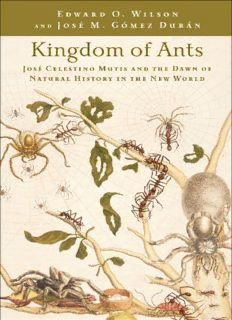
Kingdom of Ants: José Celestino Mutis and the Dawn of Natural History in the New World PDF
Preview Kingdom of Ants: José Celestino Mutis and the Dawn of Natural History in the New World
Kingdom of Ants KINGDOM OF ANTS José Celestino Mutis and the Dawn of Natural History in the New World EDWARD O. WILSON and JOSÉ M. GÓMEZ DURÁN © 2010 Edward O. Wilson and José M. Gómez Durán All rights reserved. Published 2010 Printed in the United States of America on acid-free paper 2 4 6 8 9 7 5 3 1 The Johns Hopkins University Press 2715 North Charles Street Baltimore, Maryland 21218-4363 www.press.jhu.edu LIBRARY OF CONGRESS CATALOGING-IN-PUBLICATION DATA Wilson, Edward O. Kingdom of ants : José Celestino Mutis and the dawn of natural history in the New World / Edward O. Wilson and José M. Gómez Durán. p. cm. ISBN-13: 978-0-8018-9785-6 (hardcover : alk. paper) ISBN-10: 0-8018-9785-8 (hardcover : alk. paper) 1. Mutis, José Celestino, 1732–1808. 2. Botanists—Colombia—Biography. 3. Botanists—Spain—Biography. 4. Ants—Research—South America— History—18th century. I. Gómez Durán, José María. II. Title. QK31.M8W55 2010 595.79’6092—dc22 2010011046 A catalog record for this book is available from the British Library. Special discounts are available for bulk purchases of this book. For more information, please contact Special Sales at 410-516-6936 or [email protected]. The Johns Hopkins University Press uses environmentally friendly book materials, including recycled text paper that is composed of at least 30 percent post-consumer waste, whenever possible. All of our book papers are acid-free, and our jackets and covers are printed on paper with recycled content. Oh Sacred God! How much time and perseverance are needed to discover the secrets of nature! JOSÉ CELESTINO MUTIS, SEPTEMBER 30, 1780 CONTENTS Prologue ONE Who Was Mutis? TWO The Making of an Eighteenth-Century Naturalist THREE The Scientific Contributions of José Celestino Mutis FOUR Mutis Seeks Advice FIVE Mutis Begins His Study of Ants SIX Ants Are Transported by Ships SEVEN Ant Plants and Plant Ants EIGHT Mutis Learns about the Mule-Train (Leafcutter) Ants NINE Unending Struggles against the Mule-Train Ants TEN Ant Wars ELEVEN Mutis Solves the Mystery of the Nomadic Pataloas TWELVE Mutis Measures the Size of an Army-Ant Colony THIRTEEN Mutis Tracks the Armies of Ants FOURTEEN Mutis Studies the Gender of Ants and Makes an Amazing Discovery FIFTEEN Mutis’ Other Ants SIXTEEN How Good a Scientist Was Mutis? Epilogue Acknowledgments Kingdom of Ants PROLOGUE Late in 1760 José Celestino Mutis, a young Spanish physician and botanist, arrived in the New World in what was then called the New Kingdom of Granada. In current political geography, this area constitutes the southern half of Central America and the northern part of South America. Mutis traveled from the Caribbean port of Cartagena de Indias up the Magdalena River on his way to the capital, which lay east on the high plateau of Santa Fe de Bogotá. Somewhere on the bank of the Magdalena, probably near the point of disembarkation at Mariquita, he walked into the tropical dry forest that lined the riverbanks. There he began a scientific study of a kind never before attempted. It was so esoteric it might not even have been previously imagined: he made a list of all the species of ants he could find.1 It was in a sense a blind journey. Of the species he recorded, two kinds of the arriera (mule-train) ants had names the local people used. The rest he made up out of thin air. His list contained twelve species. Thus began the earliest extended scientific program in entomology in the New World. In the four decades that followed, during a distinguished career as the first scientist and natural philosopher in what is now the nation of Colombia, Mutis accumulated a large amount of information on ants, and he wrote two books about his findings. Unlike his botanical research, both of these treatises were lost, and during the two centuries following Mutis’ death in 1808, the substance of his extensive research was mostly forgotten. But not completely. That Mutis had done such work was known among scholars in Colombia and Spain in the nineteenth and twentieth centuries. List of ant species in José Celestino Mutis’ handwriting, with English translations (document catalogued as “Real Jardin Botánico de Madrid, Fondo Documental José Celestino Mutis, III, 11, 1, 20”). In the mid-1900s, the great Colombian historian Hernández de Alba discovered the complete diaries of Mutis.2 He put the scattered pages in order, arranged them into a coherent series, and published them. Of the 1,200 published pages in the Alba collection, more than 100, inserted among Mutis’ botanical observations, describe his findings. This material, rich in detail, amounts to Mutis’ original field notes. In this work, for the first time, we have undertaken to reconstruct the substance and story of what this fascinating figure discovered. In doing so, we hope to reveal something about the dawn of natural history research in the New World.
Description: